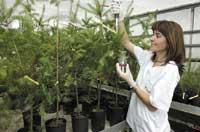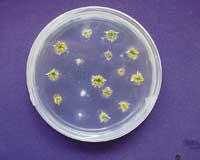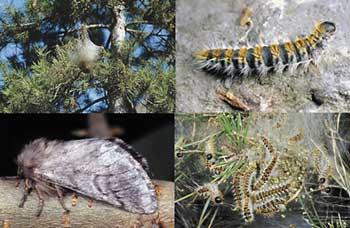Genetic improvement of pines

The genetic improvement program was launched in 1982. First, we explored the pine plantations in Euskal Herria and selected the best pines, about 80 in total. The selection of these pines was made taking into account the production characteristics, since they were larger or had fewer branches. In fact, having fewer branches, wood has fewer eyes or knots and therefore higher quality.
Following the traditional method, the shoots of these pines were first taken, with which a pine nursery was formed. For a few years the growth of the pines was allowed, to later carry out pollinations between them. With the seeds obtained from these crosses between the eighty best pines new plants were produced, in which there were genetic improvements to be able to measure them.
However, the amount of plants obtained by this method was not able to replace the amount of P. radiata that was cultivated in the forests. Plants obtained by genetic improvement accounted for only 5% of the total P. radiatas. In view of this, researchers and the forestry sector prioritized the diagnosis of the program and the search for methods to increase the number of plants.
Methods to get more pine


To solve the problem of seed quantity, NEIKER has developed cloning techniques such as organogenesis of sprouts or seeds. These techniques do not follow the traditional method of obtaining new pine plants, that is, obtaining new plants from seeds, crosses and seeds. They are all more direct paths.
The organogenesis of the shoots, for example, allows to obtain clones of adult pines by sowing in vitro their shoots. In this way, multiple desired copies of trees of very special and good characteristics are obtained.
On the other hand, the organogenesis of seeds is also possible; in vitro techniques produce many sprouts of a seed. From each of these shoots you get a plant that allows you to obtain large amounts of plants from small amounts of seeds.
All these laboratory techniques are very expensive. Therefore, to bring these special genotypes to the mountain in the necessary quantities, this year an intermediate route will be launched.
Patch reproduction
On this intermediate path, once cloned in the laboratory the trees selected in the program of genetic improvement, their branches will be planted in the orchards. There, through proper pruning, the production of branches will be optimized, it is expected that the first year will be around 7 new branches, the second year 15 and the third 30. In this way, instead of starting seeds, new pine plants will be obtained that will be taken to the forests.
Therefore, through the use of rapid techniques of genetic selection, in vitro laboratory clonations and branch based plant production may be planted in greater quantity and in less time pine plants that suppose a real genetic improvement. In addition, the techniques currently developed around Pinus radiata can be adapted in the coming years to other species such as holly. In this way, genetic improvement will also be applied to the benefit of endangered species.

In addition to the problem of seed quantity, health has a great importance in the production of the sector. In view of the damage caused by fungi and insects in pines, it was decided to take into account the characteristics that would guarantee their health. Soil management and forestry have already begun to be studied.
In order to integrate health characteristics into the program, a new selection was made in forests. During this period the healthiest pines were selected and, together with the existing ones, they were planted in nurseries. These pine nurseries were genetically diversified.
At the same time, techniques or rapid tests were developed to know the characteristics of the pines.
Therefore, in terms of health, to know if pines are resistant more direct methods are used. To do this, wounds occur in young pines where fungi are placed. Measuring the reaction of the pine, that is, the length of the wound and the time it takes to heal, the behavior of the adult pine against fungi is foreseen.
In addition, normally, resistance to a fungus is encoded by several genes, so it is not easy, following the traditional method, to pass these characteristics to future generations at crosses. It may be in some seeds and not in others.
The program detects the presence of trees with a certain degree of guarantee and transfers these characteristics to forest plantations.





